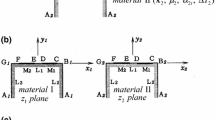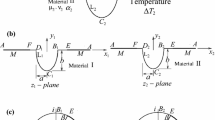Abstract
A solution of problem of two dissimilar materials bonded at one interface subjected to temperature is derived. To obtain a closed-form solution, a rational mapping function and a complex variable method are used. The coefficients of the homogeneous part of the stress function are expressed by Dunders’ parameters, but loading term of temperature is not expressed by them. As a demonstration, semi-strips bonded at one part at the ends are considered. The each strip is subjected to uniform temperature. Examples of stress distributions are shown. The relations of stress and temperature on the interface are described. Debondings on both sides of the interface are considered. Stress intensity of debonding (SID) is defined, and the values are investigated for various debonding lengths. And the debonding extension or the crack initiation into the material is investigated. The effects of material constants (Dundurs’ parameter) on SID are also investigated. By changing mapping function, other geometries can be analyzed.
Similar content being viewed by others
References
Cherepanov G.P.: Mechanics of Brittle Fracture. McGraw-Hill, New York (1977)
Piva A., Viola E.: Biaxial load effects on a crack between dissimilar media. Eng. Fract. Mech. 13, 143–174 (1980)
Sih, G.C., Chen, E.P.: Cracks in Composite Materials. Mechanics Fracture. Martinas Nijhoff, The Hague (1981)
Rice J.C.: Elastic fracture mechanics concepts for interfacial cracks. ASME J. Appl. Mech. 55, 98–103 (1988)
Murakami, Y. (Chief ed.): Stress Intensity Factors Handbook, vols. 1, 2. Pergamon Press, Oxford (1986)
Murakami, Y. (Chief ed.): Stress Intensity Factors Handbook, vol. 3. The Society of Materials Science, Japan and Pergamon Press, Oxford (1992)
Murakami, Y. (Chief ed.): Stress intensity factors handbook, vols. 4, 5. The Society of Materials Science, Japan and Elsevier, Amsterdam (2001)
Comminou M.: An overview of interface cracks. Eng. Fract. Mech. 37(1), 197–208 (1990)
Theocaris P.S., Dafermos K.: The elastic strip under mixed boundary conditions. ASME-E J. Appl. Mech. 31, 714–716 (1964)
Hess M.S.: The end problem for a laminated elastic strip—I. The general solution. J. Compos. Mater. 3, 262–280 (1969)
Hess M.S.: The end problem for a laminated elastic strip—II. Differential expansion stresses. J. Compos. Mater. 3, 630–641 (1969)
Chow T.W., Hirth J.P.: Stress distribution in a bimaterial plate under uniform external loadings. J. Compos. Mater. 4, 102–112 (1970)
Keer L.M.: Stress analysis for bonded layers. ASME-E J. Appl. Mech. 41, 679–638 (1974)
Keer L.M., Chantaramungkorn K.: Stress analysis for a double lap joint. ASME-E J. Appl. Mech. 42, 353–357 (1975)
Bogy D.B.: The plane solution for joined dissimilar elastic semi strips under tension. ASME-E J. Appl. Mech. 42, 93–98 (1975)
Adams G.G., Bogy D.B.: The plane solution for bending of joined dissimilar elastic semi-infinite strips. Int. J. Solids Struct. 12, 239–249 (1976)
Delale F., Erdogan F.: Bonded orthotropic strips with cracks. Int. J. Fract. 15(4), 343–364 (1979)
Adams G.G.: A semi-infinite elastic strip bonded to an infinite strip. ASME-E J. Appl. Mech. 47, 789–794 (1980)
Kundu T.: Transient response of an interface crack in a layered plate. ASME-E J. Appl. Mech. 53, 579–596 (1986)
Suhir, E.: Stresses in bi-metal thermostats. ASME-E J. Appl. Mech. 53, 657–660 (1986)
Lee K.Y.: Boundary element analysis of stress intensity factors for bimaterial interface cracks. Eng. Fract. Mech. 29(4), 461–472 (1988)
Matas P.P.L., McMeeking R.M., Charalambides P.G., Drory M.D.: A method for calculating stress intensities in bimaterial fracture. Int. J. Fract. 40(4), 235–254 (1989)
Tan C.L., Gao Y.L.: Treatment of bimaterial interface crack problems using the boundary element method. Eng. Fract. Mech. 36(6), 919–932 (1990)
Hasebe N., Okumura M., Nakamura T.: Partially bonded bimaterial plane under tension. J. Eng. Mech. 116(9), 2017–2034 (1990)
Hasebe N., Okumura M., Nakamura T.: Solution of bonded dissimilar planes under couples. J. Eng. Mech. 116(12), 2722–2737 (1990)
Hasebe, N., Okumura, M., Nakamura, T.: A crack and debonding at the edge of bonded bimaterial half planes under couples. Jpn. Soc. Mater. Sci. Jpn. 39(445), 1405–1410 (in Japanese) (1990)
Tsai M.Y., Morton J.: The stresses in a thermally loaded bimaterial interface. Int. J. Solids Struct. 28(8), 1053–1075 (1991)
Okumura, M., Hasebe, N., Nakamura, T.: Conditions of a crack initiation or debonding extension at a debonded tip of the partially bonded bimaterial half planes. Proc. Jpn. Soc. Civ. Eng. 428, 77–86 (in Japanese) (1991)
Okumura M., Hasebe N., Nakamura T.: Cracking and debonding on bimaterial interface under uniform loading. ASCE J. Eng. Mech. 118(6), 1113–1127 (1992)
Okumura, M., Hasebe, N., Nakamura, T.: Stress analysis of conditions for an initial cracking and a debonding development. In: 35th Japan Congress of Materials Research, Society of Materials Science, Japan, pp. 205-212 (1992)
Hasebe N., Okumura M., Nakamura T.: Bonded bi-material half planes with semi-elliptical notch under tension along the interface. J. Appl. Mech. 59, 77–84 (1992)
Hasebe, N., Kato, S., Ueda, A., Nakamura, T.: Stress analysis of dissimilar strip with debondings. Trans. Jpn. Soc. Mech. Eng. 66(577A), 1959–1966 (in Japanese) (1994)
Hasebe N., Kato S., Ueda A., Nakamura T.: Stress analysis of bimaterial strip with debondings under tension. JSME Int. J. 39(2A), 157–165 (1996)
Hasebe N., Kato S., Nakamura T.: Bimaterial problem of strip with debondings under tension and bending. Am. Soc. Test. Mater. STP 1220(25), 206–221 (1995)
Okumura M., Hasebe N., Nakamura T.: Bimaterial plane with elliptic hole under uniform tension normal to the interface. Int. J. Fract. 71, 293–310 (1995)
Frankle M., Mung D., Yang Y.Y.: Stress singularities in a bimaterial joint with inhomogeneous temperature distribution. Int. J. Solids Struct. 33(14), 2039–2054 (1996)
Banks-Sills L., Sherer A.: A conservative integral for determining stress intensity factor of a bimaterial notch. Int. J. Fract. 115(1), 1–25 (2002)
Chang, J., Xu, J.Q.: The singular stress field and stress intensity factors of a crack terminating at a bimaterial interface. Int. J. Mech. 49(7), 888–879 (2007)
Lan X., Noda N., Mihinaka K., Zhang Y.: The effect of material combinations and relative crack size to the stress intensity factors at the crack tip of a bi-material bonded strips. Eng. Fract. Mech. 78, 2572–2584 (2011)
Dundurs J.: Effect of elastic constants on stress in composite under plane deformation. J. Compos. Mater. 1, 310–322 (1967)
Muskhelishvili, N.I.: Some basic problems of mathematical theory of elasticity, 4th ed. Noordfoff, The Netherlands (1963)
Hasebe N., Horiuchi Y.: Stress analysis for a strip with semi-elliptical notches or crack on both sides by means of rational mapping function. Ing. Arch. 47(3), 169–179 (1978)
Hasebe N., Inohara S.: Stress analysis of a semi-infinite plate with an oblique edge crack. Ing. Arch. 49(1), 51–62 (1980)
Hasebe N., Wang X.: Complex variable method for thermal stress problem. J. Therm. Stresses 28, 595–648 (2005)
Salganic R.L.: The brittle fracture of cemented body. PMM J. Appl. Math. Phys. 27(5), 1468–1478 (1963)
Hasebe N., Tsutsui S., Nakamura T.: Debondings at a semielliptical rigid inclusion on the rim of a half plane. ASME E J. Appl. Mech. 55, 574–579 (1988)
Author information
Authors and Affiliations
Corresponding author
Rights and permissions
About this article
Cite this article
Hasebe, N., Kato, S. Solution of problem of two dissimilar materials bonded at one interface subjected to temperature. Arch Appl Mech 84, 913–931 (2014). https://doi.org/10.1007/s00419-014-0840-3
Received:
Accepted:
Published:
Issue Date:
DOI: https://doi.org/10.1007/s00419-014-0840-3




